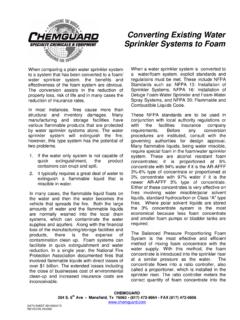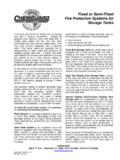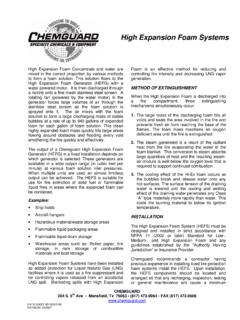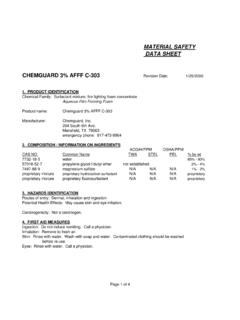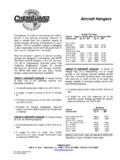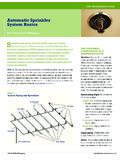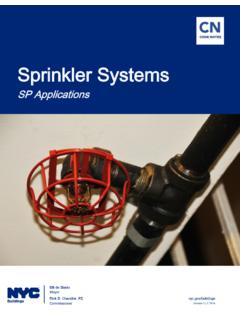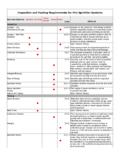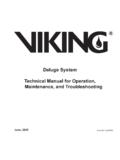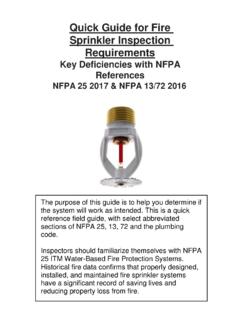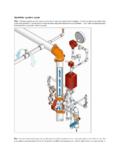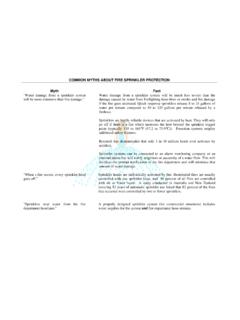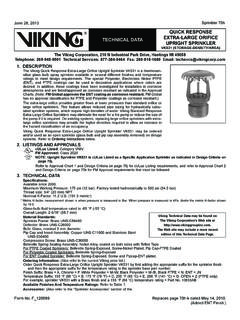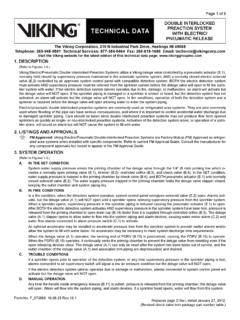Transcription of Converting Existing Water Sprinkler Systems to Foam
1 When comparing a plain Water Sprinkler system to a system that has been converted to a foam/ Water Sprinkler system , the benefits and effectiveness of the foam system are obvious. The conversion assists in the reduction of property loss, risk of life and in many cases the reduction of insurance rates. In most instances, fires cause more than structural and inventory damages. Many manufacturing and storage facilities have various flammable products that are protected by Water Sprinkler Systems alone. The Water Sprinkler system will extinguish the fire; however, this type system has the potential of two problems. 1. If the Water only system is not capable of quick extinguishment, the product containers can erupt and spill. 2. It typically requires a great deal of Water to extinguish a flammable liquid that is miscible in Water .
2 In many cases, the flammable liquid floats on the Water and then the Water becomes the vehicle that spreads the fire. Both the large amounts of Water and the flammable liquids are normally washed into the local drain Systems , which can contaminate the Water supplies and aquifers. Along with the financial loss of the manufacturing/storage facilities and products, there is the expense of contamination clean up. Foam Systems can facilitate in quick extinguishment and Water reduction. In a single year, the National Fire Protection Association documented fires that involved flammable liquids with direct losses of over $1 billion. The extended losses including the close of businesses cost of environmental clean-up and increased insurance costs are inconceivable. Converting Existing Water Sprinkler Systems to Foam When a Water Sprinkler system is converted to a Water /foam system , explicit standards and regulations must be met.
3 These include NFPA Standards such as: NFPA 13: Installation of Sprinkler Systems , NFPA 16: Installation of Deluge Foam- Water Sprinkler and Foam- Water Spray Systems , and NFPA 30: Flammable and Combustible Liquids Code. These NFPA standards are to be used in conjunction with local authority regulations or with the facilities insurance company requirements. Before any conversion procedures are instituted, consult with the governing authorities for design approval. Many flammable liquids, being Water miscible, require special foam in the foam/ Water Sprinkler system . These are alcohol resistant foam concentrates; it is proportioned at 6% concentrate with 94% Water if it is the AR-AFFF 3%-6% type of concentrate or proportioned at 3% concentrate with 97% Water if it is the newer AR-AFFF 3% type of concentrate.
4 Either of these concentrates is very effective on fires involving Water miscible/polar solvent liquids, standard hydrocarbon or Class A type fires. Where polar solvent liquids are stored the 3% concentrate system is the most economical because less foam concentrate and smaller foam pumps or bladder tanks are required. The Balanced Pressure Proportioning Foam system is the most effective and efficient method of mixing foam concentrate with the Water supply. With this method, the foam concentrate is introduced into the Sprinkler riser at a similar pressure as the Water . The concentrate flows into a ratio controller, also called a proportioner, which is installed in the Sprinkler riser. The ratio controller meters the correct quantity of foam concentrate into the CHEMGUARD 204 S. 6th Ave Mansfield, Tx 76063 (817) 473-9964 FAX (817) 473-0606 DATA SHEET #D10D03170 REVISION: 09/2005 Water as the Water flows through the ratio controller to the Sprinkler heads.
5 It is very important to determine the system demand, which will dictate the size of the ratio controller installed in the riser. It is also very important that the foam concentrate be fed into the ratio controller at a pressure, which is similar to the Water pressure, as it enters into the same ratio controller. This is accomplished by using either a Bladder Tank or a positive displacement foam pump with an In-line Balanced Pressure Proportioner (ILBP). With the bladder tank system , the foam concentrate is stored in a flexible bladder, which is installed inside of a pressure vessel. When the system is installed correctly, a portion of the pressurized Water supply is routed into the bladder tank which forces the foam concentrate out of the bladder through piping and into the ratio controller.
6 When the system Water pressurizing the bladder tank fluctuates, the pressure of the foam concentrate discharging out of the bladder tank fluctuates at the same pressure. The In-line Balanced Proportioner system (ILBP) incorporates an atmospheric foam concentrate storage tank and uses a positive displacement foam pump to pump the concentrate from the tank to the ILBP unit, which is installed in the Sprinkler riser. The pump is to have the capacity to supply foam to the entire Sprinkler system . A pressure-balancing valve is installed in each ILBP and reacts according to the pressure demands of the foam- Water Sprinkler system . If the volume of concentrate is not required due to a low demand from the Sprinkler system , the unused foam concentrate is returned back to the atmospheric storage tank via a pressure control valve which is installed in the concentrate return line.
7 An ILBP is normally more suitable on a closed head foam- Water Sprinkler system or where a bladder tank cannot be located in close proximity to the Sprinkler riser and the concentrate has to be pumped some distance from the concentrate supply tank to where the ratio controller is installed. The ILBP system requires a reliable foam concentrate pump and if electric driven, a dedicated electrical supply. Bladder tanks will work as long as there is sufficient Water pressure and the necessary minimum flow rate is achieved through the ratio controller to enable accurate proportioning. The system can be balanced hydraulically to enable the foam concentrate and the Water to meet at the ratio controller at similar pressures. With the new technology, improved foam concentrates, and methods of injecting the foam concentrate into the Water supply, it has opened the door to convert many Existing Water Sprinkler Systems to foam at an acceptable cost.
8 This cost of the conversion is out-weighed by the multiple benefits enjoyed by the customer when the conversion takes place. For more information technical assistance, contact Chemguard and we will assist you in designing a suitable and cost efficient system that complies with all relevant NFPA Fire Codes. CHEMGUARD 204 S. 6th Ave Mansfield, Tx 76063 (817) 473-9964 FAX (817) 473-0606 DATA SHEET #D10D03170 REVISION: 09/2005
